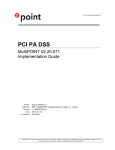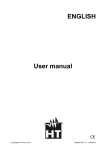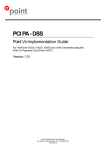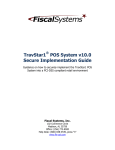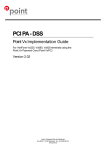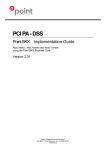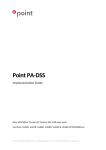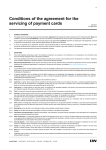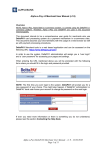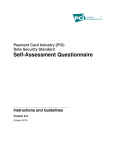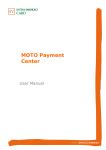Download PCI PA DSS - Verifone Baltic
Transcript
PCI PA DSS MultiPOINT 03.20.072.xxxxx Implementation Guide Author: Filename: Version: Date: Circulation: Sergejs Melnikovs D01_MultiPOINT_Implementation_Guide_v2_0.docx 2.0 (RELEASE) 2015-06-15 Restricted Copyright (c) 2015 Verifone Baltic SIA. All rights reserved. Copying and/or redistribution of this information in whole or in part without the express permission of Verifone Baltic SIA is prohibited. PCI PA DSS: MultiPOINT 03.20.072.xxxxx Implementation Guide Author : Sergejs Melnikovs Created : 2010-04-06 Version: 2.0 Circulation : Restricted Edited : 2015-06-15 Page 2 (21) Contents 1 Introduction................................................................................................................... 4 1.1 Purpose ................................................................................................................. 4 1.2 Document Use ....................................................................................................... 4 1.3 References ............................................................................................................ 5 1.4 Update History ....................................................................................................... 5 1.5 Terminology ........................................................................................................... 5 2 SUMMARY OF PCI DSS REQUIREMENTS ................................................................ 7 2.1 Protecting sensitive cardholder data ...................................................................... 7 2.1.1 Requirement 1: Do not retain full magnetic stripe, card validation code or value (CAV2, CID, CVC2), or PIN block data ........................................................... 7 2.1.2 Requirement 1.1.4: Historical data deletion ..................................................... 7 2.1.3 Requirement 1.1.5: Securely delete any sensitive data used for debugging or troubleshooting ......................................................................................................... 8 2.1.4 Requirement 2: Protect stored cardholder data ............................................... 8 2.1.5 Requirement 2.1: Purging cardholder data ...................................................... 9 2.1.6 Requirement 2.2: Mask PAN when displayed ................................................. 9 2.1.7 Requirement 2.3: Render PAN unreadable anywhere it is stored ................... 9 2.1.8 Requirement 2.5: Protect keys ...................................................................... 10 2.1.9 Requirement 2.6: Implement key management ............................................. 10 2.2 User IDs, secure authentication and user access logging ................................... 10 2.2.1 Requirement 3.1: Unique user IDs and secure authentication for administrative access ............................................................................................. 11 2.2.2 Requirement 3.2 & 3.4: Unique user IDs and secure authentication for access to servers etc. ......................................................................................................... 11 2.2.3 Requirement 4.1 & 4.2: Implement automated audit trails ............................. 11 2.2.4 Requirement 4.4: Facilitate centralized logging ............................................. 12 2.3 Secure application development .......................................................................... 12 2.3.1 Requirement 5.4: Use only necessary and secure components ................... 12 2.4 Wireless technology and network implementation ............................................... 12 2.4.1 Requirement 6: Protect wireless transmissions ............................................. 12 2.4.2 Requirement 6.1: Securely implement wireless technology .......................... 13 2.4.3 Requirement 6.2: Secure transmission of cardholder data over wireless networks ................................................................................................................. 13 2.4.4 Requirement 8.2: Must only use secure services, protocols, daemons and other components .................................................................................................. 14 2.5 Data storage and remote access/updates ........................................................... 14 2.5.1 Requirement 9: Cardholder data must never be stored on a server connected to the Internet ......................................................................................................... 14 2.5.2 Requirement 9.1: Store cardholder data only on servers not connected to the Internet ................................................................................................................... 15 2.5.3 Requirement 10.1: Implement two-factor authentication for remote access to payment application ............................................................................................... 15 2.5.4 Requirement 10.2.1: Securely deliver remote payment application updates . 15 2.5.5 Requirement 10.2.3: Securely implement remote access software ............... 16 2.6 Sensitive traffic/access encryption ....................................................................... 16 2.6.1 Requirement 11.1: Secure transmissions of cardholder data over public networks ................................................................................................................. 16 Copyright (c) 2015 Verifone Baltic SIA. All rights reserved. Copying and/or redistribution of this information in whole or in part without the express permission of Verifone Baltic SIA is prohibited. PCI PA DSS: MultiPOINT 03.20.072.xxxxx Implementation Guide Author : Sergejs Melnikovs Created : 2010-04-06 Version: 2.0 Circulation : Restricted Edited : 2015-06-15 Page 3 (21) 2.6.2 Requirement 11.2: Encrypt cardholder data sent over end-user messaging technologies ........................................................................................................... 16 2.6.3 Requirement 12.1 & 12.2: Encrypt all non-console administrative access .... 17 3 MultiPOINT application key management .................................................................. 18 Annexes ........................................................................................................................ 19 A1 Terminal files ........................................................................................................ 19 A2 Application Version Numbering policy .................................................................. 20 A3 Instances where PAN is displayed ....................................................................... 21 Copyright (c) 2015 Verifone Baltic SIA. All rights reserved. Copying and/or redistribution of this information in whole or in part without the express permission of Verifone Baltic SIA is prohibited. PCI PA DSS: MultiPOINT 03.20.072.xxxxx Implementation Guide Author : Sergejs Melnikovs Created : 2010-04-06 Version: 2.0 Circulation : Restricted Edited : 2015-06-15 Page 4 (21) 1 Introduction 1.1 Purpose The Payment Card Industry Data Security Standard (PCI-DSS) defines a set of requirements for the configuration, operation, and security of payment card transactions in your business. If you use Verifone MultiPOINT payment application in your business to store, process, or transmit payment card information, this standard and this guide apply to you. The requirements are designed for use by assessors conducting onsite reviews and for merchants who must validate compliance with the PCI DSS. Failure to comply with these standards can result in significant fines if a security breach should occur. For more details about PCI DSS, please see the following link: http://www.pcisecuritystandards.org This guide is updated whenever there are changes in MultiPOINT software that affect PCI DSS and is also reviewed annually and updated as needed to reflect changes in the MultiPOINT as well as the PCI standards. Guidelines how to download the latest version of this document could be found on the following web site http://www.verifone.lv/ The Payment Card Industry has also set the requirements for software applications that store, process or transmit cardholder data. These requirements are defined by the Payment Card Industry Payment Application Data Security Standard (PCI PA-DSS). In order to facilitate for you to get a PCI DSS assessment the Verifone software application has been approved by PCI to comply with the PCI PA-DSS requirements. Note: This guide refers to MultiIPOINT software versions on the PCI web site “List of Validated Payment Applications” that have been validated in accordance with PCI PA-DSS. If you cannot find the version running on your MultiPOINT on that list please contact our helpdesk at Verifone Baltic in order to upgrade your terminal. http://www.pcisecuritystandards.org/ 1.2 Document Use This PA-DSS Implementation Guide contains information for proper use of the Verifone MultiPOINT payment application. Verifone Baltic SIA does not possess the authority to state that a merchant may be deemed “PCI Compliant” if information contained within this document is followed. Each merchant is responsible for creating a PCI-compliant environment. The purpose of this guide is to provide the information needed during installation and operation of the MultiPOINT payment application in a manner that will support a merchant’s PCI DSS compliance efforts. Note 1: Both the System Installer and the controlling merchant must read this document. Note 2: This document must also be used when training ECR integrators/resellers at initial workshops. Copyright (c) 2015 Verifone Baltic SIA. All rights reserved. Copying and/or redistribution of this information in whole or in part without the express permission of Verifone Baltic SIA is prohibited. PCI PA DSS: MultiPOINT 03.20.072.xxxxx Implementation Guide Author : Sergejs Melnikovs Created : 2010-04-06 Version: 2.0 Circulation : Restricted Edited : 2015-06-15 Page 5 (21) 1.3 References (1) (2) (3) (4) (5) Payment Card Industry – Payment Application Data Security Standard v3.1 Payment Card Industry – Data Security Standard v3.1 MultiPOINT User Manual v1.3 Terminal Audit Log v1.7 Verifone Baltic – Terminal Software Version Numbering Specification v1.4.1 1.4 Update History Ver. Name Date Comments 1.00 Sergejs Melnikovs 2010-04-08 Original version 1.01 Janis Grikis 2010-04-09 Reviewed 1.3 Sergejs Melnikovs 2010-06-09 Corrected according to GAP Analysis Report on April 27, 2010 1.4 Sergejs Melnikovs 2010-07-28 Correction according to GAP Analysis Report on July 23, 2010 1.5 Sergejs Melnikovs 2011-01-20 Correction according PA-DSS v1.2 requirement 4.2 1.6 Sergejs Melnikovs 2013-06-19 Annual review and update the document according to PA DSS version 2.0 requirements 1.7 Sergejs Melnikovs 2013-07-09 Added application version on title page 1.8 Sergejs Melnikovs 2013-07-17 Added notes about TMS in chapter 2 1.9 Sergejs Melnikovs 2014-07-18 Minor rework of the document according to MultiPOINT version 02.20.071. Added annex about version methodology 2.0 Sergejs Melnikovs 2015-06-15 Document rebranding. Updated according to PCI DSS & PCI PA DSS version 3.1 requirements 1.5 Terminology MultiPOINT: Terminal Payment Application for use in Baltic States (Estonia, Latvia, Lithuania) PCI-DSS: Payment Card Industry Data Security Standard. Retailers that use applications to store, process or transmit payment card data are subject to the PCI-DSS standard. PA-DSS: Payment Application Data Security Standard is a standard for validation of payment applications that store, process or transmit payment card data. Applications that comply with PA-DSS have built in protection of card data and hereby facilitates for retailers to comply with PCI-DSS. Cardholder Data: PAN, Expiration Date, Cardholder Name and Service Code. Service Code: A three digit code from the magnetic stripe data defining (1) Interchange and technology, (2) Authorization processing and (3) Range of services and PIN requirements. PAN: Primary Account Number. PAN, also called card number, is part of the magnetic stripe data and is also printed or embossed on the card. PAN can also be stored in the chip of the card. Copyright (c) 2015 Verifone Baltic SIA. All rights reserved. Copying and/or redistribution of this information in whole or in part without the express permission of Verifone Baltic SIA is prohibited. PCI PA DSS: MultiPOINT 03.20.072.xxxxx Implementation Guide Author : Sergejs Melnikovs Created : 2010-04-06 Version: 2.0 Circulation : Restricted Edited : 2015-06-15 Page 6 (21) SSL: Secure Sockets Layer is a commonly used method to protect transmission across public networks. ECR: Electronic Cash Register CVV2: Card Verification Value, also called CVC2, is a three or four digit value printed on the back of the card but not encoded on the magnetic stripe or the chip. Supplying this code in a transaction is intended to verify that the card is present at the point of sale when PAN is entered manually or when a voice referral is performed. SNMP: Simple Network Management Protocol is a network protocol. It is used mostly in network management systems to monitor network-attached devices for conditions that warrant administrative attention. WPA and WPA2: Wi-Fi Protected Access is a certification program created by the Wi-Fi Alliance to indicate compliance with the security protocol created by the Wi-Fi Alliance to secure wireless computer networks. WEP: Wired Equivalent Privacy, a wireless network security standard. Sometimes erroneously called "Wireless Encryption Protocol" Magnetic Stripe Data: Track data read from the magnetic stripe, magnetic-stripe image on the chip, or elsewhere. Sensitive Authentication Data: Magnetic Stripe Data, CAV2/CVC2/CVV2/CID, PINs/PIN-block. POS: Point of sale TRSM: Tamper resistant security module 3DES: Triple DES common name for the Triple Data Encryption Algorithm AES: Advances encryption standard TMS: Terminal management system HSM: Hardware security module Copyright (c) 2015 Verifone Baltic SIA. All rights reserved. Copying and/or redistribution of this information in whole or in part without the express permission of Verifone Baltic SIA is prohibited. PCI PA DSS: MultiPOINT 03.20.072.xxxxx Implementation Guide Author : Sergejs Melnikovs Created : 2010-04-06 Version: 2.0 Circulation : Restricted Edited : 2015-06-15 Page 7 (21) 2 SUMMARY OF PCI DSS REQUIREMENTS This summary covers shortly the PCI-DSS/PA-DSS requirements that have a related PA-DSS Implementation Guide topic. It also explains how the requirement is handled in the MultiPOINT application and also explains the requirement from your aspect. The complete PCI-DSS and PA-DSS documentation can be found at: http://www.pcisecuritystandards.org Note: If a Terminal Management Systems is used as part of an authenticated remote software distribution framework for the PED, it should be evaluated by a QSA as part of any PCI DSS assessment. 2.1 Protecting sensitive cardholder data 2.1.1 Requirement 1: Do not retain full magnetic stripe, card validation code or value (CAV2, CID, CVC2), or PIN block data a. What the requirement says Do not store sensitive authentication data after authorization. Only those data elements needed for business should be stored. b. How the MultiPOINT application meets this requirement No specific setup for the MultiPOINT application is required. MultiPOINT application never stores Sensitive Authentication Data (Full Magnetic Stripe, CVV/CVV2, PIN/PIN Block). c. What this means to you If you need to enter PAN, expiration date and CVV2 manually or do a voice referral you should never write down or otherwise store PAN, expiration date or CVV2. Collect this type of data only when absolutely necessary to perform manual entry or voice referral. 2.1.2 Requirement 1.1.4: Historical data deletion a. What the requirement says Securely delete any magnetic stripe data, card validation values or codes, and PINs or PIN block data stored by previous versions of the payment application Aligns with PCI DSS Requirement 3.2 b. How the MultiPOINT application meets this requirement No specific setup for the MultiPOINT application is required. New version of MultiPOINT application does not use any cardholder’s sensitive historical data collected by previous version of the application. On installation, MuiltiPOINT application performs secure wipe for all terminal’s memory, which is available for custom application files. c. What this means to you You must make sure that historical data (magnetic stripe data, cardholder data and CVV2s) are removed from all other storage devices used in your systems, ECRs, PCs, servers etc. For further details Copyright (c) 2015 Verifone Baltic SIA. All rights reserved. Copying and/or redistribution of this information in whole or in part without the express permission of Verifone Baltic SIA is prohibited. PCI PA DSS: MultiPOINT 03.20.072.xxxxx Implementation Guide Author : Sergejs Melnikovs Created : 2010-04-06 Version: 2.0 Circulation : Restricted Edited : 2015-06-15 Page 8 (21) please refer to your vendor. Removal of sensitive authentication data is absolutely necessary for PCI DSS compliance. 2.1.3 Requirement 1.1.5: Securely delete any sensitive data used for debugging or troubleshooting a. What the requirement says Securely delete any sensitive authentication data (pre-authorization data) used for debugging or troubleshooting purposes from log files, debugging files. Aligns with PCI DSS Requirement 3.2 b. How the MultiPOINT application meets this requirement No any sensitive cardholder’s data are retrieving by MultiPOINT application in Verifone production terminals. In case when sensitive cardholder’s data need to be present in the logs for troubleshooting is only done at Verifone lab/test environment using test terminals. c. What this means to you No actions needed. 2.1.4 Requirement 2: Protect stored cardholder data a. What the requirement says Protection methods such as encryption, truncation, masking, and hashing are critical components of cardholder data protection. If an intruder circumvents other network security controls and gains access to encrypted data, without the proper cryptographic keys, the data is unreadable and unusable to that person. Other effective methods of protecting stored data should be considered as potential risk mitigation opportunities. For example, methods for minimizing risk include not storing cardholder data unless absolutely necessary, truncating cardholder data if full PAN is not needed and not sending PAN in unencrypted e-mails. b. How the MultiPOINT application meets this requirement MultiPOINT application never stores Sensitive Authentication Data (Full Magnetic Stripe, CVV/CVV2, PIN/PIN Block). For transactions Cardholder Data (PAN, Expiry Date, Cardholder Name and Service Code) are stored encrypted (3DES key is used for encryption). The key is generated and stored in the POS TRMS and never goes outside. For more information about key management see chapter 3 MultiPOINT application key management Regarding PAN masking, however, there may be some banks requirement of printing full PAN on merchant receipt for offline transactions. MultiPOINT application forms receipts using receipt templates that are received from TMS. Receipt is being formed by substituting appropriate fields of the template with relevant values, so ensuring template correctness is out of control of MultiPOINT application. c. What this means to you For cards read by the MultiPOINT application magnetic stripe reader or chip card reader you do not have to take any action. For manually entered PAN and for voice referrals it is never allowed to write down or otherwise store the PAN, expiration date or CVV2. In case you have any suspicions that the terminal could have been tampered with you have to stop making transactions and immediately contact service provider. Please check how PAN is masked on merchant receipt and immediately contact your service provider if PAN masking on a receipt doesn’t compliant with your acquirer policy. Copyright (c) 2015 Verifone Baltic SIA. All rights reserved. Copying and/or redistribution of this information in whole or in part without the express permission of Verifone Baltic SIA is prohibited. PCI PA DSS: MultiPOINT 03.20.072.xxxxx Implementation Guide Author : Sergejs Melnikovs Created : 2010-04-06 Version: 2.0 Circulation : Restricted Edited : 2015-06-15 Page 9 (21) 2.1.5 Requirement 2.1: Purging cardholder data a. What the requirement says Software vendor must provide guidance to customers regarding purging of cardholder data after expiration of customer-defined retention period. Aligns with PCI DSS Requirement 3.1 b. How the MultiPOINT application meets this requirement All cardholder data is automatically erased during the nightly batch sending or if manual batch sending is done. See the list of files in the Annex A1 Terminal files c. What this means to you All cardholder data is automatically erased during the nightly batch sending. If you want to do this operation manually it is possible. Please refer to the MultiPOINT application user manual on how to send the batch manually. This will also erase all cardholder data. If the terminal prints full PAN on merchant ticket please securely protect the receipts and securely delete them after retention period in accordance with PCI DSS Requirements 2.1.6 Requirement 2.2: Mask PAN when displayed a. What the requirement says Mask PAN when displayed (the first six and last four digits are the maximum number of digits to be displayed), such that only personnel with a legitimate business need can see the full PAN. Aligns with PCI DSS Requirement 3.3 b. How the MultiPOINT application meets this requirement Details of all instances where PAN is displayed, including but not limited to POS devices, screens, logs, and receipts are available in Annex A3 Instances where PAN is displayed c. What this means to you If the terminal prints full PAN on merchant ticket please securely protect the receipts in accordance with PCI DSS Requirement 3.3 and ensure that the data available only to personnel with a legitimate business need can see the full PAN. 2.1.7 Requirement 2.3: Render PAN unreadable anywhere it is stored a. What the requirement says Render PAN unreadable anywhere it is stored (including data on portable digital media, backup media, and in logs). The PAN must be rendered unreadable anywhere it is stored, even outside the payment application (for example, log files output by the application for storage in the customer environment) Aligns with PCI DSS Requirement 3.4 b. How the MultiPOINT application meets this requirement Details of all instances where PAN is displayed, including but not limited to POS devices, screens, logs, and receipts are available in Annex A3 Instances where PAN is displayed Copyright (c) 2015 Verifone Baltic SIA. All rights reserved. Copying and/or redistribution of this information in whole or in part without the express permission of Verifone Baltic SIA is prohibited. PCI PA DSS: MultiPOINT 03.20.072.xxxxx Implementation Guide Author : Sergejs Melnikovs Created : 2010-04-06 Version: 2.0 Circulation : Restricted Edited : 2015-06-15 Page 10 (21) c. What this means to you The customer is responsible for rendering PAN unreadable in all instances where PAN could be stored in outside of MultiPOINT application. 2.1.8 Requirements 2.4 & 2.5: Protect keys a. What the requirement says Access to keys used for cardholder data encryption must be restricted to the fewest possible number of key custodians. Keys should be stored securely. Aligns with PCI DSS Requirement 3.5 & 3.6 b. How the MultiPOINT application meets this requirement Cryptographic keys used to encrypt cardholder data are generated and stored inside tamperprotected memory area of terminals, so disclosure and misuse of keys is not possible. c. What this means to you No actions needed. 2.1.9 Requirement 2.6: Implement key management a. What the requirement says Key management procedures must be implemented to support periodic key change and replacement of known, expired or suspected compromised encryption keys. Aligns with PCI DSS Requirement 3.6 b. How the MultiPOINT application meets this requirement MultiPOINT application is designed to use TLS 1.2 or TLS 1.1 (secure configuration in accordance with NIST SP 800-52 rev 1) communication channel encryption. Cardholder or sensitive data that are sent to host during authorization are encrypted by key residing only within authorization systems HSM and secure memory of a terminal. Cardholder data stored in terminal memory is encrypted by key that is automatically generated and periodically updated by the application without any user intervention. All cryptographic material must be removed before new version of payment application deployed into the terminal. The removal of this material is automatically handled by the MultiPOINT application so you do not need to take any action. New version of MultiPOINT application does not use any encrypted historical data collected by previous version of the application Key management is briefly described in chapter 3 MultiPOINT application key management of this document. c. What this means to you Please be sure that you use valid TLS certificate of the acquirer. When the certificate close to be expired replace it by new one according to acquirer requirements. 2.2 User IDs, secure authentication and user access logging Assigning a unique identification (ID) to each person with access ensures that each individual is uniquely accountable for his or her actions. When such accountability is in place, actions taken on critical data and systems are performed by, and can be traced to, known and authorized users. Copyright (c) 2015 Verifone Baltic SIA. All rights reserved. Copying and/or redistribution of this information in whole or in part without the express permission of Verifone Baltic SIA is prohibited. PCI PA DSS: MultiPOINT 03.20.072.xxxxx Implementation Guide Author : Sergejs Melnikovs Created : 2010-04-06 Version: 2.0 Circulation : Restricted Edited : 2015-06-15 Page 11 (21) Logging mechanisms and the ability to track user activities are critical in preventing, detecting, or minimizing the impact of a data compromise. The presence of logs in all environments allows thorough tracking, alerting, and analysis when something does go wrong. Determining the cause of a compromise is very difficult without system activity logs. 2.2.1 Requirement 3.1: Unique user IDs and secure authentication for administrative access a. What the requirement says The “out of the box” installation of the payment application in place at the completion of the installation process must facilitate use of unique user IDs and secure authentication for all administrative access and for all access to cardholder data. Aligns with PCI DSS Requirements 8.1 and 8.2 b. How the MultiPOINT application meets this requirement MultiPOINT application is not provided as “out of the box” installation package. All administrative configurations are done in Terminal Management System. No local administrative access to the MultiPOINT application is possible. All possibility to affect on Cardholder Data processing through the configuration what came from TMS is described in this document. c. What this means to you No actions needed. 2.2.2 Requirement 3.2 & 3.4: Unique user IDs and secure authentication for access to servers etc. a. What the requirement says Access to PCs, servers, and databases with payment applications must require a unique user ID and secure authentication. Aligns with PCI DSS Requirements 8.1 and 8.2 b. How the MultiPOINT application meets this requirement The MultiPOINT application does not provide any accounts or access to critical data. c. What this means to you No actions needed. 2.2.3 Requirement 4.1 & 4.2: Implement automated audit trails a. What the requirement says Payment application must implement an automated audit trail to track and monitor access. Aligns with PCI DSS Requirement 10.1 and 10.2 b. How the MultiPOINT application meets this requirement The MultiPOINT application does not allow making any changes relevant to the payment functionality. All relevant changes on the terminal (system level objects creation, deletion or update, configuration changes driver update, file download and etc.) could be done only through TMS and these Copyright (c) 2015 Verifone Baltic SIA. All rights reserved. Copying and/or redistribution of this information in whole or in part without the express permission of Verifone Baltic SIA is prohibited. PCI PA DSS: MultiPOINT 03.20.072.xxxxx Implementation Guide Author : Sergejs Melnikovs Created : 2010-04-06 Version: 2.0 Circulation : Restricted Edited : 2015-06-15 Page 12 (21) actions are logged by TMS. On the TMS side there is no possibility to disable this logging functionality because disabling of the logs on the TMS side will result in the merchant’s loss of PCI DSS compliance. c. What this means to you The application uses syslog protocol for audit trails. If you need to receive this data on your syslog server too please refer to (4)Terminal Audit Log v1.7. 2.2.4 Requirement 4.4: Facilitate centralized logging a. What the requirement says Payment application must facilitate centralized logging. Aligns with PCI DSS Requirement 10.5.3 b. How the MultiPOINT application meets this requirement The MultiPOINT application provides ability to collect/analyze logging information by sending log files to remote host. The log file has syslog format and described in separate document (4)Terminal Audit Log v1.7. c. What this means to you The application uses syslog protocol for audit trails. If you need to receive this data on your syslog server too please refer to (4)Terminal Audit Log v1.7. 2.3 Secure application development 2.3.1 Requirement 5.4: Use only necessary and secure components a. What the requirement says The payment application must only use or require use of necessary and secure services, protocols, daemons, components, and dependent software and hardware, including those provided by third parties, for any functionality of the payment application. b. How the MultiPOINT application meets this requirement No unnecessary/unsecure services or protocols are used or required to be used by the MultiPOINT application. c. What this means to you No actions needed 2.4 Wireless technology and network implementation 2.4.1 Requirement 6: Protect wireless transmissions a. What the requirement says Install perimeter firewalls between any wireless networks and the cardholder data environment, and configure these firewalls to deny or control (if such traffic is necessary for business purposes) any traffic from the wireless environment into the cardholder data environment. Copyright (c) 2015 Verifone Baltic SIA. All rights reserved. Copying and/or redistribution of this information in whole or in part without the express permission of Verifone Baltic SIA is prohibited. PCI PA DSS: MultiPOINT 03.20.072.xxxxx Implementation Guide Author : Sergejs Melnikovs Created : 2010-04-06 Version: 2.0 Circulation : Restricted Edited : 2015-06-15 Page 13 (21) For wireless environments connected to the cardholder data environment or transmitting cardholder data, change wireless vendor defaults, including but not limited to default wireless encryption keys, passwords, and SNMP community strings. Ensure wireless device security settings are enabled for strong encryption technology for authentication and transmission. b. How the MultiPOINT application meets this requirement MultiPOINT application is designed to operate in a network behind a firewall. If wireless is used the MultiPOINT application supports strong encryption (WPA). c. What this means to you If you are using wireless network within your business, you must make sure, that firewalls are installed, what deny or control (if such traffic is necessary for business purposes) any traffic from the wireless environment into the MultiPOINT application environment. Please refer to your firewall manual. In case you are using a wireless network you must also make sure, that: • • • • • Encryption keys were changed from vendor defaults at installation Encryption keys are changed anytime someone with knowledge of the keys leaves the company or changes position Default SNMP community strings on wireless devices are changed Firmware on wireless devices is updated to support strong encryption, WPA/WPA2. Please note that WEP must not be used for new installations and is not allowed after June 30, 2010 Other security related vendor defaults are changed 2.4.2 Requirement 6.1: Securely implement wireless technology a. What the requirement says For payment applications using wireless technology, the wireless technology must be implemented securely. Aligns with PCI DSS Requirements 1.2.3 & 2.1.1 b. How the MultiPOINT application meets this requirement If wireless is used the MultiPOINT application supports strong encryption (WPA). The wireless encryption is applied on top of the 3DES encryption. Also all data sent to and from the MultiPOINT application is always protected using TLS. c. What this means to you No actions needed. 2.4.3 Requirement 6.2: Secure transmission of cardholder data over wireless networks • What the requirement says For payment applications using wireless technology, payment application must facilitate use of industry best practices (for example, IEEE 802.11i) to implement strong encryption for authentication and transmission. Aligns with PCI DSS Requirements 1.2.3, 2.1.1, & 4.1.1 Copyright (c) 2015 Verifone Baltic SIA. All rights reserved. Copying and/or redistribution of this information in whole or in part without the express permission of Verifone Baltic SIA is prohibited. PCI PA DSS: MultiPOINT 03.20.072.xxxxx Implementation Guide Author : Sergejs Melnikovs Created : 2010-04-06 Version: 2.0 Circulation : Restricted Edited : 2015-06-15 Page 14 (21) • How the MultiPOINT application meets this requirement If wireless is used the MultiPOINT application supports strong encryption (WPA). The wireless encryption is applied on top of the 3DES encryption. Also all data sent to and from the MultiPOINT application is always protected using TLS. The type of wireless encryption could be set up only through TMS and there is not possibility to assign PCI DSS not compatible type of connection. • What this means to you For wireless networks transmitting cardholder data or connected to the cardholder data environment, verify that industry best practices (for example, IEEE 802.11i) are used to implement strong encryption for authentication and transmission. For other actions please refer to part 2.4.1c of this document. 2.4.4 Requirement 8.2: Must only use secure services, protocols, daemons and other components a. What the requirement says The payment application must only use or require use of necessary and secure services, protocols, daemons, components, and dependent software and hardware, including those provided by third parties, for any functionality of the payment application. Aligns with PCI DSS Requirement 2.2.3 b. How the MultiPOINT application meets this requirement Verifone terminal in “out of the box” configuration doesn’t use any unsecure protocol. The terminal accepts an application only if the application signed by valid production certificate. MultiPOINT application designed to use for CHD & SAD processing only secure protocols. c. What this means to you No actions needed. 2.5 Data storage and remote access/updates 2.5.1 Requirement 9: Cardholder data must never be stored on a server connected to the Internet a. What the requirement says Implement a DMZ to limit inbound and outbound traffic to only protocols that are necessary for the cardholder data environment. Limit inbound Internet traffic to IP addresses within the DMZ. Do not allow internal addresses to pass from the Internet into the DMZ. b. How the MultiPOINT application meets this requirement MultiPOINT application is designed to operate in a network behind a firewall. MultiPOINT application also allows the use of DMZs. c. What this means to you No actions needed. Copyright (c) 2015 Verifone Baltic SIA. All rights reserved. Copying and/or redistribution of this information in whole or in part without the express permission of Verifone Baltic SIA is prohibited. PCI PA DSS: MultiPOINT 03.20.072.xxxxx Implementation Guide Author : Sergejs Melnikovs Created : 2010-04-06 Version: 2.0 Circulation : Restricted Edited : 2015-06-15 Page 15 (21) 2.5.2 Requirement 9.1: Store cardholder data only on servers not connected to the Internet a. What the requirement says The payment application must be developed such, that the database server and web server are not required to be on the same server, nor is the database server required to be in the DMZ with the web server. Aligns with PCI DSS Requirement 1.3.7 b. How the MultiPOINT application meets this requirement MultiPOINT application does not store any cardholder data in a server connected to the internet. c. What this means to you No actions needed. 2.5.3 Requirement 10.1: Implement two-factor authentication for remote access to payment application a. What the requirement says If the payment application may be accessed remotely, remote access to the payment application must be authenticated using a two-factor authentication mechanism. Aligns with PCI DSS Requirement 8.3 b. How the MultiPOINT application meets this requirement No remote access to Verifone production terminals or the application is possible. c. What this means to you No actions needed. 2.5.4 Requirement 10.2.1: Securely deliver remote payment application updates a. What the requirement says If payment application updates are delivered via remote access into customers’ systems, software vendors must tell customers to turn on remote-access technologies only when needed for downloads from vendor, and to turn off immediately after download completes. Alternatively, if delivered via VPN or other high-speed connection, software vendors must advise customers to properly configure a firewall or a personal firewall product to secure “always-on” connections. Aligns with PCI DSS Requirements 1 and 12.3.9 b. How the MultiPOINT application meets this requirement No remote access to Verifone production terminals or the application is possible. c. What this means to you No actions needed. Copyright (c) 2015 Verifone Baltic SIA. All rights reserved. Copying and/or redistribution of this information in whole or in part without the express permission of Verifone Baltic SIA is prohibited. PCI PA DSS: MultiPOINT 03.20.072.xxxxx Implementation Guide Author : Sergejs Melnikovs Created : 2010-04-06 Version: 2.0 Circulation : Restricted Edited : 2015-06-15 Page 16 (21) 2.5.5 Requirement 10.2.3: Securely implement remote access software a. What the requirement says If vendors, resellers/integrators, or customers can access customer’s payment applications remotely, the remote access must be implemented securely. b. How the MultiPOINT application meets this requirement No remote access to Verifone production terminals or the application is possible. c. What this means to you No actions needed 2.6 Sensitive traffic/access encryption Sensitive information must be encrypted during transmission over networks that are easily accessed by malicious individuals. Miss-configured wireless networks and vulnerabilities in legacy encryption and authentication protocols can be continued targets of malicious individuals who exploit these vulnerabilities to gain privileged access to cardholder data environments. Use strong cryptography and security protocols such as TLS or IPSEC to safeguard sensitive cardholder data during transmission over open, public networks. 2.6.1 Requirement 11.1: Secure transmissions of cardholder data over public networks a. What the requirement says If the payment application sends or facilitates sending cardholder data over public networks, the payment application must support use of strong cryptography and security protocols such as TLS and Internet protocol security (IPSEC) to safeguard sensitive cardholder data during transmission over open, public networks. Aligns with PCI DSS Requirement 4.1 b. How the MultiPOINT application meets this requirement All sensitive data sent to and from the MultiPOINT application is always protected using TLS encryption protocol. c. What this means to you No actions needed. 2.6.2 Requirement 11.2: Encrypt cardholder data sent over end-user messaging technologies a. What the requirement says If the payment application facilitates sending of PANs by end-user messaging technologies (for example, e-mail, instant messaging, chat), the payment application must provide a solution that renders the PAN unreadable or implements strong cryptography, or specify use of strong cryptography to encrypt the PANs. Aligns with PCI DSS Requirement 4.2 b. How the MultiPOINT application meets this requirement Copyright (c) 2015 Verifone Baltic SIA. All rights reserved. Copying and/or redistribution of this information in whole or in part without the express permission of Verifone Baltic SIA is prohibited. PCI PA DSS: MultiPOINT 03.20.072.xxxxx Implementation Guide Author : Sergejs Melnikovs Created : 2010-04-06 Version: 2.0 Circulation : Restricted Edited : 2015-06-15 Page 17 (21) MultiPOINT application is not able to send any cardholder data using end-user messaging technologies. c. What this means to you No actions needed. 2.6.3 Requirement 12.1 & 12.2: Encrypt all non-console administrative access a. What the requirement says If the payment application facilitates non-console administrative access, include instructions on how to configure the application to use strong cryptography (such as SSH, VPN, or TLS) for encryption of all non-console administrative access to payment application or servers in cardholder data environment.. Aligns with PCI DSS Requirement 2.3 b. How the MultiPOINT application meets this requirement No remote access to Verifone production terminals (nor the application) is possible. c. What this means to you No actions needed. Copyright (c) 2015 Verifone Baltic SIA. All rights reserved. Copying and/or redistribution of this information in whole or in part without the express permission of Verifone Baltic SIA is prohibited. PCI PA DSS: MultiPOINT 03.20.072.xxxxx Implementation Guide Author : Sergejs Melnikovs Created : 2010-04-06 Version: 2.0 Circulation : Restricted Edited : 2015-06-15 Page 18 (21) 3 MultiPOINT application key management The main idea is that the Key Management process is automatic and controlled only by the MultiPOINT application. It doesn’t require any key injections from outside. A 3DES key is used for encryption. The key is generated and stored in the POS TRSM and never goes outside. • • • • • 3DES(112 bit) double length encryption key is generated by the terminal’s operating system. The encryption key is stored in tamper resistant secure module’s memory of the terminal. Key transmission is not required. New key is generated when terminal starts for the 1st time, after terminal software update, after every batch sending (at least once per 24 hours) and after manual transaction deletion operation. If the key generation process was not successful then the application doesn’t allow making any payment transactions, only service functions are allowed. Before a new key generation the old key is destroyed and cryptographic material is removed. If for some reason the application/terminal is not able to send the batch for a time longer than 30 days, then the application doesn’t allow to make a new payment transactions without sending the batch. Copyright (c) 2015 Verifone Baltic SIA. All rights reserved. Copying and/or redistribution of this information in whole or in part without the express permission of Verifone Baltic SIA is prohibited. PCI PA DSS: MultiPOINT 03.20.072.xxxxx Implementation Guide Author : Sergejs Melnikovs Created : 2010-04-06 Version: 2.0 Circulation : Restricted Edited : 2015-06-15 Page 19 (21) Annexes A1 Terminal files In a table below represented list of files on the terminal what can contains any cardholder data or logs of important events from the terminal. File Name Description Cardholders Protection data FILEREVERSALLIST.LST Payment list queue for PAN & Expiry Encrypted cancellation date FILETRANSSETUP.CFG Last payment data and batch PAN & Expiry Encrypted counters date FILETRANSSETUP.CPY Last payment data and batch PAN & Expiry Encrypted counters, backup copy date FILETRANSLIST.LST 24h Payment list PAN & Expiry Encrypted date FILETRANSLIST.CPY 24h Payment list, backup copy PAN & Expiry Encrypted date FILEPREAUTHLIST.LST Pre-authorization list PAN & Expiry Encrypted date FILEGOODSLIST.LST Payment details for goods PAN Encrypted payments FILELASTTRANS.DAT Last transaction record PAN & Expiry Encrypted date FILETMPTRANS.DAT Information about unfinished PAN & Expiry Encrypted transactions (for ECR requests date processing) TRANS_.....TXT Payment statistics Masked PAN & Expiry date DEBUG.LOG Application debug information Masked PAN & Expiry date VK_LOG.LOG Payment flow “step by step” log Masked PAN for Valsts Kase configuration TRACE.LOG Transaction errors and speed Masked PAN & measurement log Expiry date STATS.LOG Communication statistics log ERROR.LOG Application Error event log SYS.LOG Audit log *.TRACE Transaction errors and speed measurement logs, compressed Archive for sending to terminal management system, contains compressed log files “Dealoyal” receipt copy (loyalty bonus points) List of unsent transactions, where “x” is acquirer index (0-6) *.SRZ PRINTCOPYDEALOYAL.LST BATCH_MON_x.TXT Masked PAN & Expiry date Masked PAN & Expiry date Masked PAN Masked PAN Copyright (c) 2015 Verifone Baltic SIA. All rights reserved. Copying and/or redistribution of this information in whole or in part without the express permission of Verifone Baltic SIA is prohibited. PCI PA DSS: MultiPOINT 03.20.072.xxxxx Implementation Guide Author : Sergejs Melnikovs Created : 2010-04-06 Version: 2.0 Circulation : Restricted Edited : 2015-06-15 Page 20 (21) A2 Application Version Numbering policy Below represented MultiPOINT application version numbering methodology what is based on common Verifone Baltic version numbering policy (reference (5) Verifone Baltic – Terminal Software Version Numbering Specification v1.24.1) Application version numbering format: <NNNNNNNNNN> <XX>.<YY>.<ZZZ> .<BBBBB>, where : Format NNNNNNNNNN XX Subject Software Name; Major application version number YY Payment application identifier ZZZ Minor application version number BBBBB build number Description Name of the application This version number indicates the major version of the payment application. It is increased every time, when major changes are done, according to PA-DSS rules. Number is never restarted within the application life cycle Number is attached to a combination of particular payment application and “major” (from PA DSS prospective) payment functionality. For current application it has fixed value : 20 - MultiPOINT payment application, main configuration; This number is increased every time some changes to the functionality of the application are done, which are not considered “major” by PA DSS rules for payment application. Number can be (but not mandatory should be) restarted, when “Payment application major version number” or “Payment application identifier” is changed. In cases, when changes contains only bug fixes of existing functionality, but functionality itself isn’t changed, minor application number should not be increased Increased every time, when new software package is created, even on minor bug fixes, when no changes to neither version numbers are made. Number is never restarted during the application life cycle. Should mandatory present, but should not be mandatory presented to external parties, when indicating application version. If a new package contains changes what could be classified as Low-impact or High-impact from PA DSS prospective than together with build number other relevant part of version number MUST be changed So let’s look on MultiPOINT 03.20.072.00390: MultiPOINT 03 20 072 00390 Software Name; Major application version number Payment application identifier Minor application version number build number Copyright (c) 2015 Verifone Baltic SIA. All rights reserved. Copying and/or redistribution of this information in whole or in part without the express permission of Verifone Baltic SIA is prohibited. PCI PA DSS: MultiPOINT 03.20.072.xxxxx Implementation Guide Author : Sergejs Melnikovs Created : 2010-04-06 Version: 2.0 Circulation : Restricted Edited : 2015-06-15 Page 21 (21) A3 Instances where PAN is displayed Below represented instances where MultiPOINT application can show cardholders data: Instance DISPLAY Description Manual PAN entry dialog none Voice authorization dialog none CARDHOLDERS RECEIPT (terminal printer and/or ECR protocol) MERCHANT RECEIPT (terminal printer and/or ECR protocol) Masked Regular transaction Masked Offline transaction none Preauthorization none Preauthorization’s list receipt (terminal printer and/or ECR protocol) Last EMV transaction params receipt (terminal printer and/or ECR protocol) ECR protocol: transaction result message Protection Masked Masked Regular transaction Masked Offline transaction none Preauthorization none Copyright (c) 2015 Verifone Baltic SIA. All rights reserved. Copying and/or redistribution of this information in whole or in part without the express permission of Verifone Baltic SIA is prohibited.





















